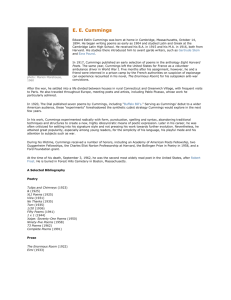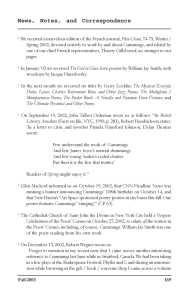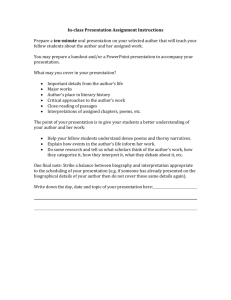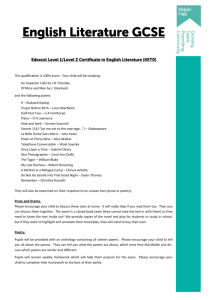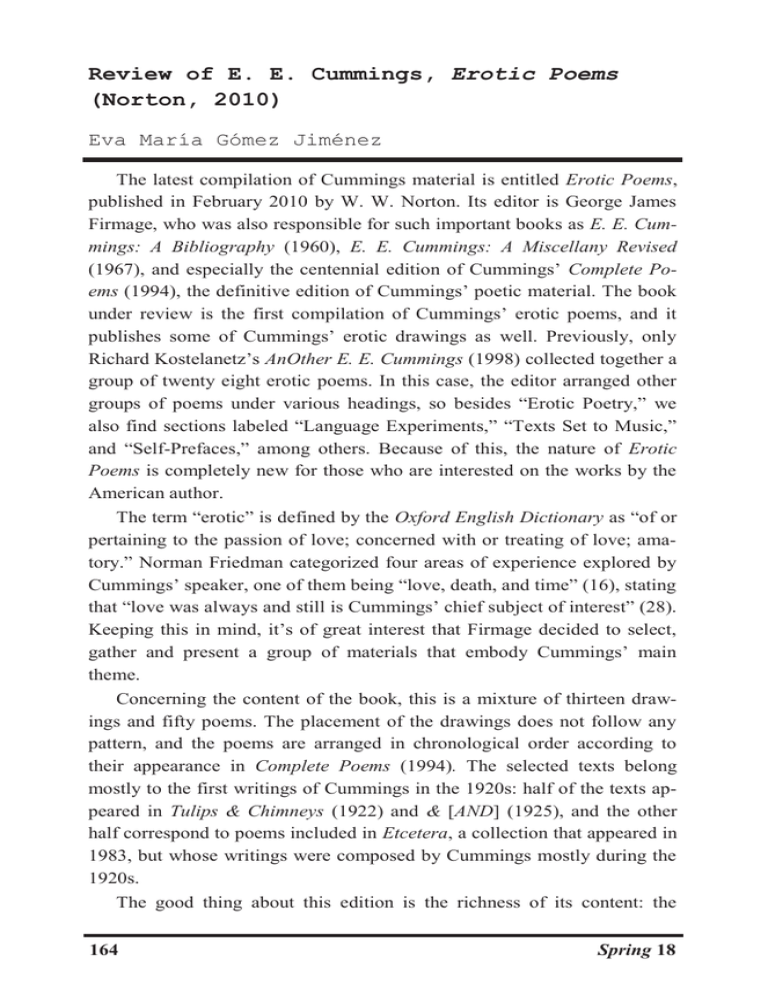
Review of E. E. Cummings, Erotic Poems
(Norton, 2010)
Eva María Gómez Jiménez
The latest compilation of Cummings material is entitled Erotic Poems,
published in February 2010 by W. W. Norton. Its editor is George James
Firmage, who was also responsible for such important books as E. E. Cummings: A Bibliography (1960), E. E. Cummings: A Miscellany Revised
(1967), and especially the centennial edition of Cummings’ Complete Poems (1994), the definitive edition of Cummings’ poetic material. The book
under review is the first compilation of Cummings’ erotic poems, and it
publishes some of Cummings’ erotic drawings as well. Previously, only
Richard Kostelanetz’s AnOther E. E. Cummings (1998) collected together a
group of twenty eight erotic poems. In this case, the editor arranged other
groups of poems under various headings, so besides “Erotic Poetry,” we
also find sections labeled “Language Experiments,” “Texts Set to Music,”
and “Self-Prefaces,” among others. Because of this, the nature of Erotic
Poems is completely new for those who are interested on the works by the
American author.
The term “erotic” is defined by the Oxford English Dictionary as “of or
pertaining to the passion of love; concerned with or treating of love; amatory.” Norman Friedman categorized four areas of experience explored by
Cummings’ speaker, one of them being “love, death, and time” (16), stating
that “love was always and still is Cummings’ chief subject of interest” (28).
Keeping this in mind, it’s of great interest that Firmage decided to select,
gather and present a group of materials that embody Cummings’ main
theme.
Concerning the content of the book, this is a mixture of thirteen drawings and fifty poems. The placement of the drawings does not follow any
pattern, and the poems are arranged in chronological order according to
their appearance in Complete Poems (1994). The selected texts belong
mostly to the first writings of Cummings in the 1920s: half of the texts appeared in Tulips & Chimneys (1922) and & [AND] (1925), and the other
half correspond to poems included in Etcetera, a collection that appeared in
1983, but whose writings were composed by Cummings mostly during the
1920s.
The good thing about this edition is the richness of its content: the
164
Spring 18
reader may find in it a broad range of erotic texts representing different
approaches that include the sexual act, prostitutes, praise to the body of the
lover, sexual metaphors, and many others. At the same time, some of the
poems will be easily recognized by the reader; this is the case for “may i
feel said he” (42), “i like my body when it is with your” (36), or “she being
Brand” (37). In addition, because almost half of the collection belongs to
Etcetera, the reader will also find some hidden treasures such as “you said
Is” (60) or “b” (71). A mixture of tones is also evident here: while some of
the texts are clear and direct, even dirty in some cases, others are beautiful,
subtle, and delicate. The same applies to form as well, for the edition includes experimental poems such as “n w” (70) and traditional ones, especially sonnets. See, for instance, “she had that softness which is falsity” (67) or “and this day it was Spring….us” (25).
Despite the richness of its content, some problems need to be highlighted in this edition: first, some of the poems occupy two pages, getting
broken this way. (Compare to other editions, especially the Complete Poems (1994), whose texts occupy only one page, so that the reader can have
a global vision of the poem as a whole unit. In these cases, the spacing between lines is smaller in order to achieve this unity.) Cummings also tried
binding the book in a different way, as Kennedy explains when talking
about No Thanks (1935): “The book came out finally in the spring of 1935,
bound in an unique way. The pages were gathered at the top rather than at
the left side: a two-page poem could then be read continuously rather than
breaking for a page” (351). Since this unity principle is not taken in consideration, the reading process for some poems in Erotic Poems becomes
harder, and the perception of the poem gets distorted. Secondly, this edition
has kept the numeration of the poems in their original publication, which in
this case corresponds to Complete Poems. This has a double effect, for the
numbers of the poems do not correspond to their actual position in the book
(as Cummings usually did in his publications) and they have been taken as
the title of the poems, when it is evident that Cummings rarely wrote a title
for them. This gives a strange, unclear impression. Finally, there is no indication which book each poem belongs to, or even the date of publication,
so the reader faces the poems directly, without any other information.
Perhaps the most surprising aspect of the book is its organization: it
does not include any other section apart from the content itself, in contrast
to other compilations of Cummings’ work where editors tend to include
acknowledgements, a preface, an introduction, and even an index of first
Fall 2011
165
lines. This is the case for AnOther E. E. Cummings (1998) and Complete
Poems 1904-1962 (1994), just to give a few examples. The only additional
information is placed in the cover flap, a very brief presentation of the book
as a “generous selection of those erotic poems and sketches, culled from
Cummings’s original manuscripts.” This austerity of a global layout is confusing for readers who are not used to reading Cummings, and even for
those who are familiar with his poetry. Although layout is a formal concern, I find it quite useful to ease the process of reading, especially when
we are talking about a writer who is widely considered to be somewhat
difficult to understand.
In short, this is a good compilation for someone who wants to approach
Cummings’ eroticism, but at the same time, the reader will find some problems dealing with the layout, the lack of extra information or the visual
arrangement of the poems on the page. Despite these drawbacks, I’m sure
the reader would not be disappointed for he will find the essence of Cummings poetry treated with an instinctive, pure feeling: love, passion, sex.
—Universidad de Granada, Spain
Works Cited
Cummings, E. E. Complete Poems 1904-1962. Ed. George J. Firmage. New
York: Liveright, 1994.
—. E. E. Cummings: A Miscellany Revised. Ed. George J. Firmage. New
York: October House, 1965.
—. Etcetera: The Unpublished Poems of E. E. Cummings. Eds. George J.
Firmage and Richard S. Kennedy. New York: Liveright, 1983.
Firmage, George. J. E. E. Cummings: A Bibliography. Middletown:
Wesleyan UP, 1960.
Friedman, Norman. E. E. Cummings: The Art of his Poetry. Baltimore:
John Hopkins, UP. 1960.
Kostelanetz, Richard and John Rocco, eds. AnOther E. E. Cummings. New
York: Liveright, 1998.
166
Spring 18



